Who pays for and who benefits from health care services in Uganda?
- PMID: 25638215
- PMCID: PMC4324659
- DOI: 10.1186/s12913-015-0683-9
Who pays for and who benefits from health care services in Uganda?
Abstract
Background: Equity in health care entails payment for health services according to the capacity to pay and the receipt of benefits according to need. In Uganda, as in many African countries, although equity is extolled in government policy documents, not much is known about who pays for, and who benefits from, health services. This paper assesses both equity in the financing and distribution of health care benefits in Uganda.
Methods: Data are drawn from the most recent nationally representative Uganda National Household Survey 2009/10. Equity in health financing is assessed considering the main domestic health financing sources (i.e., taxes and direct out-of-pocket payments). This is achieved using bar charts and standard concentration and Kakwani indices. Benefit incidence analysis is used to assess the distribution of health services for both public and non-public providers across socio-economic groups and the need for care. Need is assessed using limitations in functional ability while socioeconomic groups are created using per adult equivalent consumption expenditure.
Results: Overall, health financing in Uganda is marginally progressive; the rich pay more as a proportion of their income than the poor. The various taxes are more progressive than out-of-pocket payments (e.g., the Kakwani index of personal income tax is 0.195 compared with 0.064 for out-of-pocket payments). However, taxes are a much smaller proportion of total health sector financing compared with out-of-pocket payments. The distribution of total health sector services benefitsis pro-rich. The richest quintile receives 19.2% of total benefits compared to the 17.9% received by the poorest quintile. The rich also receive a much higher share of benefits relative to their need. Benefits from public health units are pro-poor while hospital based care, in both public and non-public sectors are pro-rich.
Conclusion: There is a renewed interest in ensuring equity in the financing and use of health services. Based on the results in this paper, it would seem that in order to safeguard such equity, there is a need for policy that focuses on addressing the health needs of the poor while continuing to ensure that the burden of financing health services does not rest disproportionately on the poor.
Figures
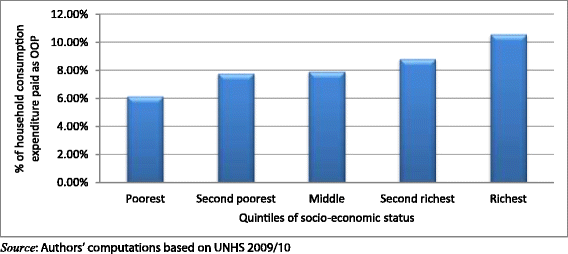
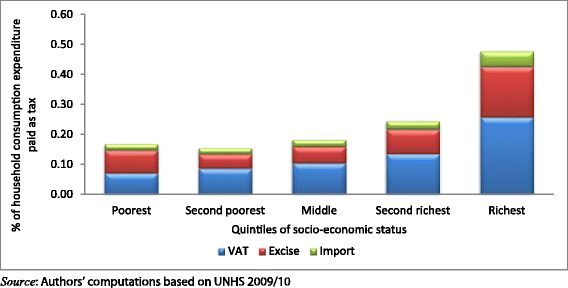
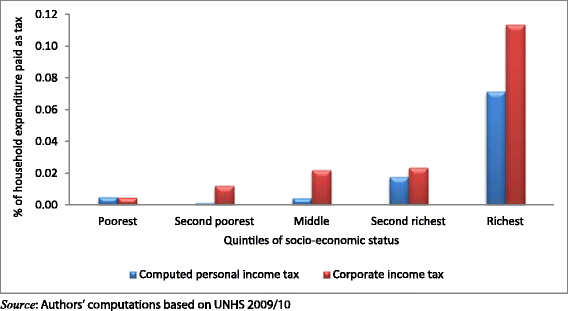
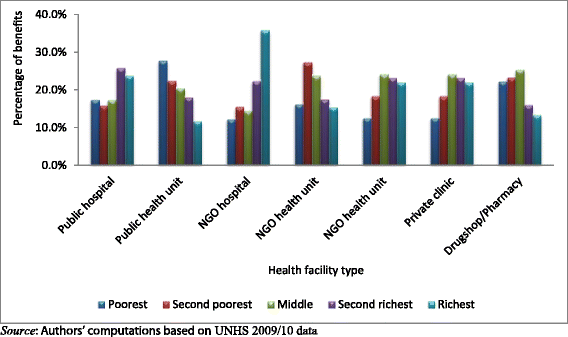
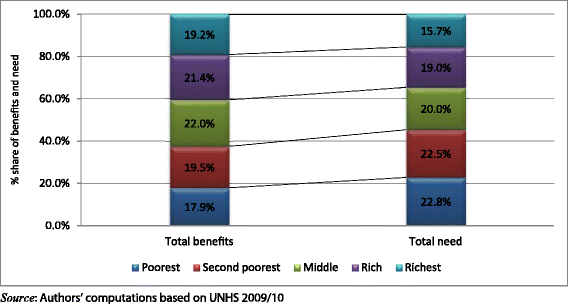
Similar articles
-
Accounting for the burden and redistribution of health care costs: Who uses care and who pays for it.Health Serv Res. 2020 Apr;55(2):224-231. doi: 10.1111/1475-6773.13258. Epub 2020 Jan 27. Health Serv Res. 2020. PMID: 31984503 Free PMC article.
-
Equity in health financing of Guangxi after China's universal health coverage: evidence based on health expenditure comparison in rural Guangxi Zhuang autonomous region from 2009 to 2013.Int J Equity Health. 2017 Sep 29;16(1):174. doi: 10.1186/s12939-017-0669-9. Int J Equity Health. 2017. PMID: 28962656 Free PMC article.
-
Who pays and who benefits from health care? An assessment of equity in health care financing and benefit distribution in Tanzania.Health Policy Plan. 2012 Mar;27 Suppl 1:i23-34. doi: 10.1093/heapol/czs018. Health Policy Plan. 2012. PMID: 22388497
-
Is health care financing in Uganda equitable?Afr Health Sci. 2009 Oct;9 Suppl 2(Suppl 2):S52-8. Afr Health Sci. 2009. PMID: 20589107 Free PMC article. Review.
-
Hong Kong's domestic health spending--financial years 1989/90 through 2004/05.Hong Kong Med J. 2008 Apr;14 Suppl 2:2-23. Hong Kong Med J. 2008. PMID: 18587162 Review.
Cited by
-
How to do (or not to do) … a health financing incidence analysis.Health Policy Plan. 2018 Apr 1;33(3):436-444. doi: 10.1093/heapol/czx188. Health Policy Plan. 2018. PMID: 29346547 Free PMC article.
-
Reasons for participating in a randomised clinical trial: The volunteers' voices in the COSTOP trial in Uganda.Contemp Clin Trials Commun. 2017 May 17;7:44-47. doi: 10.1016/j.conctc.2017.05.007. eCollection 2017 Sep. Contemp Clin Trials Commun. 2017. PMID: 29696167 Free PMC article.
-
Assessment of equity in healthcare financing and benefits distribution in Tanzania: a cross-sectional study protocol.BMJ Open. 2021 Sep 2;11(9):e045807. doi: 10.1136/bmjopen-2020-045807. BMJ Open. 2021. PMID: 34475146 Free PMC article.
-
Assessing equity of access and affordability of care among South Sudanese refugees and host communities in two districts in Uganda: a cross-sectional survey.BMC Health Serv Res. 2022 Sep 16;22(1):1165. doi: 10.1186/s12913-022-08547-5. BMC Health Serv Res. 2022. PMID: 36114536 Free PMC article.
-
Equity assessment of maternal and child healthcare benefits utilization and distribution in public healthcare facilities in Bangladesh: a benefit incidence analysis.Popul Health Metr. 2023 Sep 5;21(1):12. doi: 10.1186/s12963-023-00312-y. Popul Health Metr. 2023. PMID: 37670352 Free PMC article.
References
-
- United Nations. United Nations General Assemby resolution on universal access. Accessed August 2, 2013 from http://www.un.org/ga/search/view_doc.asp?symbol=A/67/L.36&referer=http:/...; 2012.
-
- Mills A, Ataguba JE, Akazili J, Borghi J, Garshong B, Makawia S, Mtei G, Harris B, Macha J, Meheus F. Equity in financing and use of health care in Ghana, South Africa, and Tanzania: implications for paths to universal coverage. Lancet. 2012;380:126–33. doi: 10.1016/S0140-6736(12)60357-2. - DOI - PubMed
Publication types
MeSH terms
LinkOut - more resources
Full Text Sources
Other Literature Sources
Medical

